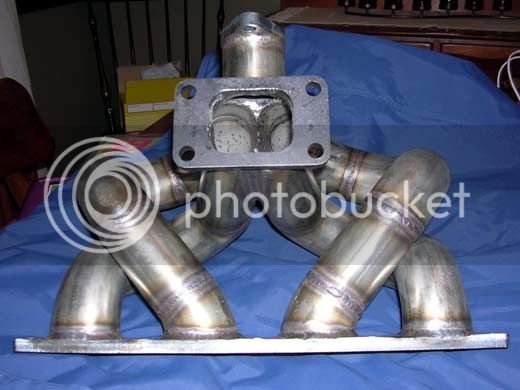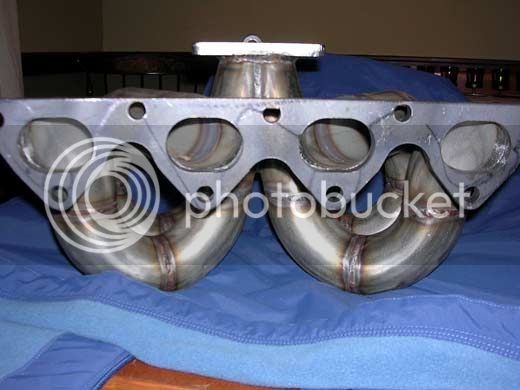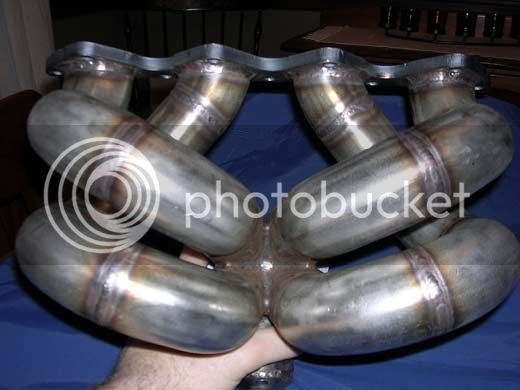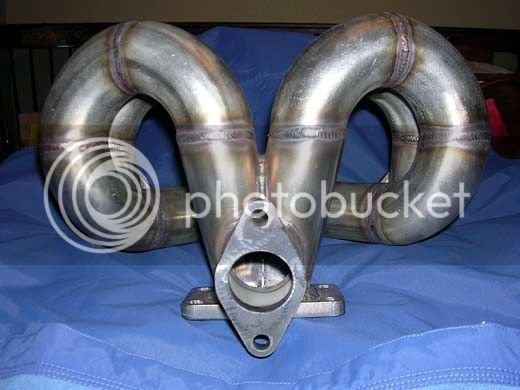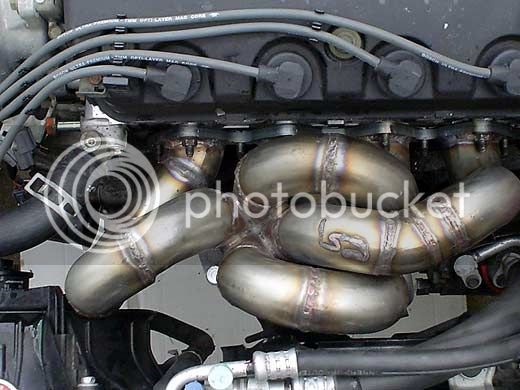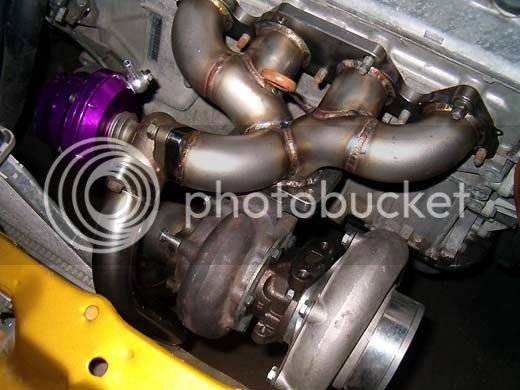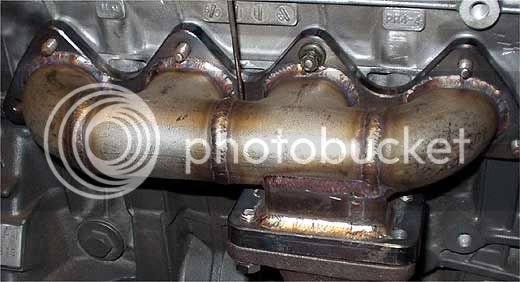You are using an out of date browser. It may not display this or other websites correctly.
You should upgrade or use an alternative browser.
You should upgrade or use an alternative browser.
Equal Vs. Unequal Turbo headers
- Thread starter Lextreme II
- Start date
The 1UZFE EGR Delete Kit is available for sale here.
Exhaust manifold design entails many parameters of which equal length primary piping is but one. Equal length can tune the accoustic and pulse wave energy to increase power in certain RPM ranges.
In most turbo applications it is very difficult to achieve ideal primary length AND equal length. To do so is both expensive and can come at the cost of packaging of other desireable street systems such as AC. Long runner equal length headers can reduce heat and therefore reduce low speed boost response.
For street use it is hard to beat the effectiveness and practicallity of a compact aerodynamicaly shaped short runner turbo manifold.
In most turbo applications it is very difficult to achieve ideal primary length AND equal length. To do so is both expensive and can come at the cost of packaging of other desireable street systems such as AC. Long runner equal length headers can reduce heat and therefore reduce low speed boost response.
For street use it is hard to beat the effectiveness and practicallity of a compact aerodynamicaly shaped short runner turbo manifold.
CressidaV8
New Member
There's an old, really in depth discussion about this on an Aussie forum that you should take a look at.
http://www.performanceforums.com/forums/showthread.php?t=67142389
Sorry about dragging up an oldish thread.
Darren.
http://www.performanceforums.com/forums/showthread.php?t=67142389
Sorry about dragging up an oldish thread.
Darren.
here's a pic of a 935 header.
these are factory designed by porsche motorsport.
this engine has been run in 750 hp trimf or 24 hrs.
From this I would conclude that its not as important as one would think.
There's room to make them equal length and cost wasn't really an issue.
If it would have made more power I'm sure they would have done it.
I think it has to do with compressed exhaust. The spring rate of the exaust air column is much higher than an N/A motor.
Jeff
these are factory designed by porsche motorsport.
this engine has been run in 750 hp trimf or 24 hrs.
From this I would conclude that its not as important as one would think.
There's room to make them equal length and cost wasn't really an issue.
If it would have made more power I'm sure they would have done it.
I think it has to do with compressed exhaust. The spring rate of the exaust air column is much higher than an N/A motor.
Jeff
As someone who builds and tests manifolds for a living, I can prob help a little. Forget the tuned length pipes altogether on any and every street engine any of us will ever own. The simple fact is unless you have enough room to make long sweeping uncompromised bends, you will LOSE power with a poorly designed equal manifold. Its simple, the more bends in a runner, the less it will flow. Now heat that air up massively, and at every bend, it absorbs some of teh heat and slows it down, and lastly, make it as turbulent as possible, and each bend creates even more restriction.
There are times where its easy to make some of the pipes close to equal length without compromising flow, in such cases its worthwhile to make them close to equal length simply because you can without the drawbacks discussed above. in any other circumstance, make the pipes as smooth as possible to get to the destination required. The part of the manifold however that makes the MOST difference, is the collector. Especially for all you V8 guys where its easy as cake to make a merge collector with your drop saw and some straight pipe. Start by making your collector first, attach this to the turbo flange for the turbo with some tack welds, and bolt the collector/flange to the turbo. Now work backwards and work out with what you have where the turbo will have to sit to allow room/fitment.
When you've got it close to figured out, you may need a helping hand to measure from the head plate on the block out to the turbo flange, cut some 10mm rod and weld 1 end to the turbo flange, and with the turbo in position, the other end to the head flange. Put a few supports in so it will hold the weight of the turbo, bolt the turbo back on and check all your positions, measurements and locations. Adjust if needed, and if not, you now have your working jig. Simply work backwarsd in the smoothest fashion from turbo flange to head plate allowing for things such as dump pipe, cooler pipes, oil lines and wiring/engine bay stuff.
The difference between the pro's and home people isn't skill, its purely practice. Even with the welding, it costs little to finish the whole manifolds tacked together, and take them to a proffesional to weld up for you. The other benifit we have is we have built so many manifolds in our time and had so many mistakes, we learn very quickly to take ALL parameters into account, dump pipe, cooler pipes, inlet pipes, oil and water lines, heat reflection, etc etc etc. Write a list of what you need to account for, and check every single one off as you go, plan carefully, and you'll end up with a winner:tongue2:
6BOOST
There are times where its easy to make some of the pipes close to equal length without compromising flow, in such cases its worthwhile to make them close to equal length simply because you can without the drawbacks discussed above. in any other circumstance, make the pipes as smooth as possible to get to the destination required. The part of the manifold however that makes the MOST difference, is the collector. Especially for all you V8 guys where its easy as cake to make a merge collector with your drop saw and some straight pipe. Start by making your collector first, attach this to the turbo flange for the turbo with some tack welds, and bolt the collector/flange to the turbo. Now work backwards and work out with what you have where the turbo will have to sit to allow room/fitment.
When you've got it close to figured out, you may need a helping hand to measure from the head plate on the block out to the turbo flange, cut some 10mm rod and weld 1 end to the turbo flange, and with the turbo in position, the other end to the head flange. Put a few supports in so it will hold the weight of the turbo, bolt the turbo back on and check all your positions, measurements and locations. Adjust if needed, and if not, you now have your working jig. Simply work backwarsd in the smoothest fashion from turbo flange to head plate allowing for things such as dump pipe, cooler pipes, oil lines and wiring/engine bay stuff.
The difference between the pro's and home people isn't skill, its purely practice. Even with the welding, it costs little to finish the whole manifolds tacked together, and take them to a proffesional to weld up for you. The other benifit we have is we have built so many manifolds in our time and had so many mistakes, we learn very quickly to take ALL parameters into account, dump pipe, cooler pipes, inlet pipes, oil and water lines, heat reflection, etc etc etc. Write a list of what you need to account for, and check every single one off as you go, plan carefully, and you'll end up with a winner:tongue2:
6BOOST
long runners
Mr. Boost,
As a builder, do you build only turbo headers? I agree with all you have said if the application is a turbo. My learning is that the philosophy and science changes if you are talking about NA engines. Do you agree?
Everything you said not only made sense but the concept of the gases losing thermal energy at a turn was an eye opener. I knew the turns were bad and had accepted that for years. Thermal energy loss is the technical explaination I was missing. Thanks.
Bottom line: I think an engine with a good street/strip cam needs an extractor/scavanging header to function properly. Do you agree with that?
IMHO and I mean that sincerely.
Thank you
John
Mr. Boost,
As a builder, do you build only turbo headers? I agree with all you have said if the application is a turbo. My learning is that the philosophy and science changes if you are talking about NA engines. Do you agree?
Everything you said not only made sense but the concept of the gases losing thermal energy at a turn was an eye opener. I knew the turns were bad and had accepted that for years. Thermal energy loss is the technical explaination I was missing. Thanks.
Bottom line: I think an engine with a good street/strip cam needs an extractor/scavanging header to function properly. Do you agree with that?
IMHO and I mean that sincerely.
Thank you
John
equal len.
Toys,
Aspect? That throws me. What do you mean?
My question is: does equal length primary runners make a great deal of difference in the ability of a tri Y type extractor/scavanging headers to function? The qualification is "with a normally asperated engine equiped with a performance(timing overlap) cam?
There should be two negative pressure waves that hit the ex valve port during each ex cycle. The first occures when the valve just opens and that neg pulse helps start the high pressure gases flow out the port. The second neg pressure pulse hits the ex port at the very end of the ex cycle and helps pull the last bit of low pressure ex gas out of the cylinder. It is my thinking that the len of the runners is critical to this extracting function(aspect?). The other function of the extractor is to provide the minimum of back pressure. Skinny pipes provide a more intense neg pulse but big pipes yield a lower back pressure so there is an optimum point where both perform the best. I thought this was gospel for NA engines. I keep seeing posts that write that the design criteria for runner length is not important. I am confused cause you are shaking my world with that. Then again the technology before the advent of turbos NEVER saw this kind of power per unit of displacement in its most vivid imaginations. IMHQ
I don't know if I am adressing your question of "aspect".
Thanks
John
Toys,
Aspect? That throws me. What do you mean?
My question is: does equal length primary runners make a great deal of difference in the ability of a tri Y type extractor/scavanging headers to function? The qualification is "with a normally asperated engine equiped with a performance(timing overlap) cam?
There should be two negative pressure waves that hit the ex valve port during each ex cycle. The first occures when the valve just opens and that neg pulse helps start the high pressure gases flow out the port. The second neg pressure pulse hits the ex port at the very end of the ex cycle and helps pull the last bit of low pressure ex gas out of the cylinder. It is my thinking that the len of the runners is critical to this extracting function(aspect?). The other function of the extractor is to provide the minimum of back pressure. Skinny pipes provide a more intense neg pulse but big pipes yield a lower back pressure so there is an optimum point where both perform the best. I thought this was gospel for NA engines. I keep seeing posts that write that the design criteria for runner length is not important. I am confused cause you are shaking my world with that. Then again the technology before the advent of turbos NEVER saw this kind of power per unit of displacement in its most vivid imaginations. IMHQ
I don't know if I am adressing your question of "aspect".
Thanks
John
Equal length when measured from the valve (or valves) is nice because you know each cylinder is that much closer to making the same power, and that each cylinder is tuned, for the most part, to provide the same charicteristics. When going between turbo N/A & S/C. They all want slightly different things, but share some common points.
Pipe diameter greatly influances the velocity that flows through the pipe. An exhaust, just like an itnake. Actual flow & power created is not determined soly based on the restriction of a pipe as many people think. It's an equal balance of raw flow & restriction, VS the velocity it moves at. If velocity didn't matter. We'd all run 3" primary pipes & 4" exhaust pipes.
On an N/A engine, when the exhaust velocity hits around 250ft/s you're going to be around peak torque. As more exhaust flows, there is increasing backpressure & it falls off. Runner length also plays an important part in where the torque band falls. The shorter the runner, the higher up rpm wise it takes to achive that peak torque.
For lack of a better example to give you. Take a common stock FWD v6 header & compair it to a shorty v6 aftermarket header with primary pipes around 6-9" long. The aftermarket headers are notorious for only providing 10-15 horsepower over stock headers. And that is due mainly only because of a better designed y-pipe that connects the headers togteher. (It's very common to see 15-20hp gains just replacing the y-pipe). The reason in this case, is because even tho a nice pretty equal length header with a better merge looks alot better. Simply becuase of the runner length, you're going to be locked into not having the best gains until > 9,000rpm.
Now you go sticking 30-36" long primary pipes on the manifold, you start seeing 20 & 30hp increases over stock. Because the tuning of such long runners will bring the maximum gains you see out of said header down to accessable levels. More around 4500-5500rpm. (Which if you do some gearing math, most common OEM gearings are designed to keep the car accellerating around that level. Atleast with non vvt-i Toyota's. Once youg et out of first gear, Pretty much all the cars will drop down to low 4000s & run bakc up to 5900-6200rpm.)
Backpressure is the devil. No amount of backpressure is good. What hapens is that you have to make a tradeoff if you want your gains to be at acecssable rpm levels.
let's say you run 1.75" VS 1.25" primary runner lengths on your typical mild/midum modified N/A engine.
That 1.25" runner does have more backpressure than the larger runner. BUT it also has a higher velocity running through it that for the most part will more than pay for the restriction penalty.
I don't like to give you generalities, but that's pretty much true. You know unless you're making 60-70hp/c 1.25 is OK & 1.5" is plenty. After that the bigger you go, the slower it gets & all of a sudden, the peak gains yous ee come at a higher rpm range you probably are not going to get to.
Runners too short, or piping too large is nothing mroe than a waste of potential. What makes for good gains is giving the maximum gain over the maximum time.
In my case:
When I do an intake manifold, a y-pipe & on these headers I'm building right now for a guy N/A. I know that first gear will run to 6200rpm, and every gear change after that I drop back down to 4100-4300rpm. Peak torque stock is 2500-4400rpm & peak horsepower is 5200rpm. ECU likes to shift at 6200rpm.
Common since tells me that if I maximize all my efforts to increasing power at 5000-5500rpm & get good gains around that area. I get good gains at the top 1/2 of my first gear. and I get nothing but gains for the duration of ever other gear. This v6 I have won't fuel cut until 7100rpm. But it doesn't matter, our power curve is way under that so there's not much point in me addressing us making poor power nearly 2000rpm away.
See. Where I get good gains for 2500rpm where I like to tune this 3.0L v6. Someone that would concentrate on say 6500rpm would only get 1500rpm worth of good gains.
It's easy to make gains at high rpm where the Ve tanks, but just because I can average out ALOT more gains over time, you'd have to *really* make some impressive results to outrun something that's mroe accessible.
AFA "equal length". It's not like 90% of the "equal length" manifolds are qual length to begin with. Simply because the valves are never an equal distance from a center point & the majority of builders measure from the flange to the end. Not from the exhaust valve to the end.
Afew inches here & there. It only shifts the rpm around alittle bit rpm wise. You know it might hurt a crankshaft if we had tin crashafts, but we don't. Hell the intake manifolds never flow the same to each cylinder anyways. It'd be one thing if you had a big bad NHRA engine, but we don't.
The real issue you get into is diminishing returns. It would be awesome if every manifold was perfectly equal in velocity & backpressure, etc. But they're not. Once you get within a couple of inches you have to stop & ask yourself. Exactly how much more math, time, effort & materials do you want to spend fabbing.
Now if one runner is 6" longer than the others. Yeah that's pretty excessive.
And keep in mind this thread was in regards to a turbo manifold. Where barring certian circumstances, you want the exhaust to hit & exit that turbine in the biggest hurry ever. Aslong as it's not exceedingly restrictive at the upper end of your rpm range. The shorter & smaller, the better. The good news, is that you're very flexable with a turbo. You can get away with alot of differances that would be unacceptable to an N/A, or supercharged engine.
With a turbo, you're not going to run big overlap cams, so it doesn't matter so much. Just because of the nature of how a turbine spool rate is influanced directly by the amount of exhaust generated by an engine. A turbo will follow what the engine does in it's N/A form, enhance & then extend that pattern.
To recap, yes pipe diameter, runner length & the overall volume do make huge differances in manifold design, but we're talking how they affect your typical turbo install, not so much an N/A, or S/C'ed manifold.
N/A tuning. Accessability is the biggest thing to me. If you can't keep the improvements accessible in the maximum amount of time, you're wasting potential.
A try-y header. I honestly have never built, one. From what I have read people much smarter than myself say abt them. When they're done perfectly, they're great, but it takes alot of math (I've never seen), alot of trial & error, or a big truck of luck to get one right.
I wish everyone would run old fashion long tube headers simply because they're alot easier to understand. You know. Doesn't take a rocket scientists to get told to buy 1.25, or 1.5" pipe & bends, do alittle math & figure out that in general, most engines would like the length to wind up around 32-34" long. It can be crappy having to fit that much pipe in a bay & under a car, but it's not horrible.
As opposed to people making try-y mergers & never getting the runner length quite right. *Especially* if you begin to talk about the stepped tube try-y headers that have come into favor in rescent years. That just seems like a complete crap shoot to me.
For the differance headers actually make when they're close to being "right" for the powerband shape you want. Too much diminishing returns for me to deal with. I'll stick to making long tube's until someone builds a calculator on the internet that works worth a crap b/c I don't understand how the successful ones balance the size steps & the merge sections.
Besides. I like making 3-1 & 4-1 collectors LoL! They're pretty.
Pipe diameter greatly influances the velocity that flows through the pipe. An exhaust, just like an itnake. Actual flow & power created is not determined soly based on the restriction of a pipe as many people think. It's an equal balance of raw flow & restriction, VS the velocity it moves at. If velocity didn't matter. We'd all run 3" primary pipes & 4" exhaust pipes.
On an N/A engine, when the exhaust velocity hits around 250ft/s you're going to be around peak torque. As more exhaust flows, there is increasing backpressure & it falls off. Runner length also plays an important part in where the torque band falls. The shorter the runner, the higher up rpm wise it takes to achive that peak torque.
For lack of a better example to give you. Take a common stock FWD v6 header & compair it to a shorty v6 aftermarket header with primary pipes around 6-9" long. The aftermarket headers are notorious for only providing 10-15 horsepower over stock headers. And that is due mainly only because of a better designed y-pipe that connects the headers togteher. (It's very common to see 15-20hp gains just replacing the y-pipe). The reason in this case, is because even tho a nice pretty equal length header with a better merge looks alot better. Simply becuase of the runner length, you're going to be locked into not having the best gains until > 9,000rpm.
Now you go sticking 30-36" long primary pipes on the manifold, you start seeing 20 & 30hp increases over stock. Because the tuning of such long runners will bring the maximum gains you see out of said header down to accessable levels. More around 4500-5500rpm. (Which if you do some gearing math, most common OEM gearings are designed to keep the car accellerating around that level. Atleast with non vvt-i Toyota's. Once youg et out of first gear, Pretty much all the cars will drop down to low 4000s & run bakc up to 5900-6200rpm.)
Backpressure is the devil. No amount of backpressure is good. What hapens is that you have to make a tradeoff if you want your gains to be at acecssable rpm levels.
let's say you run 1.75" VS 1.25" primary runner lengths on your typical mild/midum modified N/A engine.
That 1.25" runner does have more backpressure than the larger runner. BUT it also has a higher velocity running through it that for the most part will more than pay for the restriction penalty.
I don't like to give you generalities, but that's pretty much true. You know unless you're making 60-70hp/c 1.25 is OK & 1.5" is plenty. After that the bigger you go, the slower it gets & all of a sudden, the peak gains yous ee come at a higher rpm range you probably are not going to get to.
Runners too short, or piping too large is nothing mroe than a waste of potential. What makes for good gains is giving the maximum gain over the maximum time.
In my case:
When I do an intake manifold, a y-pipe & on these headers I'm building right now for a guy N/A. I know that first gear will run to 6200rpm, and every gear change after that I drop back down to 4100-4300rpm. Peak torque stock is 2500-4400rpm & peak horsepower is 5200rpm. ECU likes to shift at 6200rpm.
Common since tells me that if I maximize all my efforts to increasing power at 5000-5500rpm & get good gains around that area. I get good gains at the top 1/2 of my first gear. and I get nothing but gains for the duration of ever other gear. This v6 I have won't fuel cut until 7100rpm. But it doesn't matter, our power curve is way under that so there's not much point in me addressing us making poor power nearly 2000rpm away.
See. Where I get good gains for 2500rpm where I like to tune this 3.0L v6. Someone that would concentrate on say 6500rpm would only get 1500rpm worth of good gains.
It's easy to make gains at high rpm where the Ve tanks, but just because I can average out ALOT more gains over time, you'd have to *really* make some impressive results to outrun something that's mroe accessible.
AFA "equal length". It's not like 90% of the "equal length" manifolds are qual length to begin with. Simply because the valves are never an equal distance from a center point & the majority of builders measure from the flange to the end. Not from the exhaust valve to the end.
Afew inches here & there. It only shifts the rpm around alittle bit rpm wise. You know it might hurt a crankshaft if we had tin crashafts, but we don't. Hell the intake manifolds never flow the same to each cylinder anyways. It'd be one thing if you had a big bad NHRA engine, but we don't.
The real issue you get into is diminishing returns. It would be awesome if every manifold was perfectly equal in velocity & backpressure, etc. But they're not. Once you get within a couple of inches you have to stop & ask yourself. Exactly how much more math, time, effort & materials do you want to spend fabbing.
Now if one runner is 6" longer than the others. Yeah that's pretty excessive.
And keep in mind this thread was in regards to a turbo manifold. Where barring certian circumstances, you want the exhaust to hit & exit that turbine in the biggest hurry ever. Aslong as it's not exceedingly restrictive at the upper end of your rpm range. The shorter & smaller, the better. The good news, is that you're very flexable with a turbo. You can get away with alot of differances that would be unacceptable to an N/A, or supercharged engine.
With a turbo, you're not going to run big overlap cams, so it doesn't matter so much. Just because of the nature of how a turbine spool rate is influanced directly by the amount of exhaust generated by an engine. A turbo will follow what the engine does in it's N/A form, enhance & then extend that pattern.
To recap, yes pipe diameter, runner length & the overall volume do make huge differances in manifold design, but we're talking how they affect your typical turbo install, not so much an N/A, or S/C'ed manifold.
N/A tuning. Accessability is the biggest thing to me. If you can't keep the improvements accessible in the maximum amount of time, you're wasting potential.
A try-y header. I honestly have never built, one. From what I have read people much smarter than myself say abt them. When they're done perfectly, they're great, but it takes alot of math (I've never seen), alot of trial & error, or a big truck of luck to get one right.
I wish everyone would run old fashion long tube headers simply because they're alot easier to understand. You know. Doesn't take a rocket scientists to get told to buy 1.25, or 1.5" pipe & bends, do alittle math & figure out that in general, most engines would like the length to wind up around 32-34" long. It can be crappy having to fit that much pipe in a bay & under a car, but it's not horrible.
As opposed to people making try-y mergers & never getting the runner length quite right. *Especially* if you begin to talk about the stepped tube try-y headers that have come into favor in rescent years. That just seems like a complete crap shoot to me.
For the differance headers actually make when they're close to being "right" for the powerband shape you want. Too much diminishing returns for me to deal with. I'll stick to making long tube's until someone builds a calculator on the internet that works worth a crap b/c I don't understand how the successful ones balance the size steps & the merge sections.
Besides. I like making 3-1 & 4-1 collectors LoL! They're pretty.
Oh, and another big thing is the collector. Most collectors in a perfect world, for the average rpm's you want a street engine to get gains at would be 9-12" long.
Compair that against most collectors you actually see in use. Normally they're only 2" press/crush bend's, or sometimes up to 4" long.
It's only going to help you if you can make a nice long collector. & what are all the try-y's running for merges? I'd say nothing more than 2-2.25" pipe cut at about a 30* angle so it merges. That's not exactly a nice long collector, with the nice long overheangs (I forget the rela name) that keeps velocity up.
The rule of thumb I've always heard is 7.5* is great, and try to keep it under 20* if you've got the room & equipment (or patience if you have to do multiple cuts) to handle it.
It's all about maximum velocity, without loosing power to restriction & then sizing it all so that you get the best gains over the largest amount of time.
Compair that against most collectors you actually see in use. Normally they're only 2" press/crush bend's, or sometimes up to 4" long.
It's only going to help you if you can make a nice long collector. & what are all the try-y's running for merges? I'd say nothing more than 2-2.25" pipe cut at about a 30* angle so it merges. That's not exactly a nice long collector, with the nice long overheangs (I forget the rela name) that keeps velocity up.
The rule of thumb I've always heard is 7.5* is great, and try to keep it under 20* if you've got the room & equipment (or patience if you have to do multiple cuts) to handle it.
It's all about maximum velocity, without loosing power to restriction & then sizing it all so that you get the best gains over the largest amount of time.
Toys, The Real Deal
Toys,
You make me proud to have only asked a question that led to that much information being shared. I am deeply impressed and grateful that you took the time for us. Thank you! Really, Thank you very much.
Long ago when expansion chambers first became popular with dirt bikes, an extensive article was published on their design. It was complicated but the math was not even in the calculas sphere. I did that math and came up with the optimum design being around 8 feet long. I fiddled with that design formula for days and even pondered building a thing that stupid just to prove the formulas wrong. I quit! More than a year later Suziki came out with the worst widow maker ever to hit the dirt called the 400 Cyclone. The pipe twisted around in front of the exhaust port and went under the left front of the bike and came out under the mid section and then went up to the seat level and then went back about 18 inches. Total length? You guessed it. Around 8 feet. I was lost at where to put it and how but the formula held and was proven. Widow Maker.
I am not lost for things to do. Really! But, I would like to pursue this. Not with the highest priority but with interest. I once had a book on Exhaust system design that was a true engineering text. It was a very tough read and I had long before that put away the math skills I needed to answer its questions. Gave it to a ex design shop owner I new back then. You sound like you have a text similar to the one that got me to the longest expansion chamber in captivity except that yours deals with 4 cycle. I have looked up ex design as a subject and that text escapes me. Can you tell me where I might find info that is presented in a format that can be digested? Your comment that the Y should be 9 inches long blows me away. Can you refer me to a publication or text that could be followed to arive at a design? I will keep your post in my notes but it won't work for design. I have read it twice and will probably read it again today. Thanks again.
I hope I can pm you and have you stay loosly involved in my progress. Ok though if you are busy, I understand.
Thanks again for your most excellent response both in spirit and tech content. Everybody has benifited, I'm sure.
John
Toys,
You make me proud to have only asked a question that led to that much information being shared. I am deeply impressed and grateful that you took the time for us. Thank you! Really, Thank you very much.
Long ago when expansion chambers first became popular with dirt bikes, an extensive article was published on their design. It was complicated but the math was not even in the calculas sphere. I did that math and came up with the optimum design being around 8 feet long. I fiddled with that design formula for days and even pondered building a thing that stupid just to prove the formulas wrong. I quit! More than a year later Suziki came out with the worst widow maker ever to hit the dirt called the 400 Cyclone. The pipe twisted around in front of the exhaust port and went under the left front of the bike and came out under the mid section and then went up to the seat level and then went back about 18 inches. Total length? You guessed it. Around 8 feet. I was lost at where to put it and how but the formula held and was proven. Widow Maker.
I am not lost for things to do. Really! But, I would like to pursue this. Not with the highest priority but with interest. I once had a book on Exhaust system design that was a true engineering text. It was a very tough read and I had long before that put away the math skills I needed to answer its questions. Gave it to a ex design shop owner I new back then. You sound like you have a text similar to the one that got me to the longest expansion chamber in captivity except that yours deals with 4 cycle. I have looked up ex design as a subject and that text escapes me. Can you tell me where I might find info that is presented in a format that can be digested? Your comment that the Y should be 9 inches long blows me away. Can you refer me to a publication or text that could be followed to arive at a design? I will keep your post in my notes but it won't work for design. I have read it twice and will probably read it again today. Thanks again.
I hope I can pm you and have you stay loosly involved in my progress. Ok though if you are busy, I understand.
Thanks again for your most excellent response both in spirit and tech content. Everybody has benifited, I'm sure.
John
Expansion chambers, etc are used on 2-strokes to this day. You see them on 2 stroke bikes/atv's still. I see them all the time in R/C aircraft engine's, tho they're loosing some prevelance over the last few years. Relatively to other mufflers they weigh alot & only give you a couple hundred rpm boost at the top.
I know what you're coming from tho.
4-strokes don't adheir to all the nice expansion chamber stuff, but yeah I wish I had a real engineering book with alot of formulas. Keep in mind... I'm talking engines that'll turn 17-25,000rpm too.
One one of the racing 0.46ci engine's I have. The most popular tuned pipe for it was about 18-24" long. (I don't remember, it's been 10 years). I went back to the OEM muffler to save some weight.
And I don't know alot of stuff. LoL! All that's just general crap. Hell I'm sure jbrady could kill me. Infact I asked him a pipe sizing question here a month ago.
I know what you're coming from tho.
4-strokes don't adheir to all the nice expansion chamber stuff, but yeah I wish I had a real engineering book with alot of formulas. Keep in mind... I'm talking engines that'll turn 17-25,000rpm too.
One one of the racing 0.46ci engine's I have. The most popular tuned pipe for it was about 18-24" long. (I don't remember, it's been 10 years). I went back to the OEM muffler to save some weight.
And I don't know alot of stuff. LoL! All that's just general crap. Hell I'm sure jbrady could kill me. Infact I asked him a pipe sizing question here a month ago.
Attachments
In a nutshell I think it sounds smart because I don't sound like a complete idiot.
See. You've got alot of builders than just buy the 3 major pipe sizes (1.25, 1.5, 1.75) because they're really cheap. Buy pressed flanges really short. They tack it together in a sorta close fashion. Then they weld it together however it fits. Which is fine, but. You know... There's room for improvement. Thats the majority of the stuff you see.
I saw one of Magnaflow's high end bulders do just that in the last day, or two on Speed...
You've got people that sorta got the general idea & atleast know how to avoid the maor no-no's. That's where I am.
Then.... You have like BurnsStainless LMAO! Or say, the designers at TopRace (Honda stuff), or say. OEM level people.
You know, like the best turbo honda manifold I could possibly make right now would probably get $600-650. The exact same thing from TopRace would fetch $1000-1200, just because... Well i'm not TopRace! And I'm not saying my best effort is even close to TopRace. But even if it was indentical in every way.
I'm still not TopRace, I still couldn't command that price!
The worst are RS4 manifolds... Buddy of mine linked me to a manifoldI could build for $200-300 bucks. Mateerials, consumeables included. Labor would be 4-5 hours. Not alot...
They wanted > $4,000, and they looked not the best.
Yeah.
Crazy...
We're all in the wrong biz. Please one of you buy an RS4 & move in with me...
See. You've got alot of builders than just buy the 3 major pipe sizes (1.25, 1.5, 1.75) because they're really cheap. Buy pressed flanges really short. They tack it together in a sorta close fashion. Then they weld it together however it fits. Which is fine, but. You know... There's room for improvement. Thats the majority of the stuff you see.
I saw one of Magnaflow's high end bulders do just that in the last day, or two on Speed...
You've got people that sorta got the general idea & atleast know how to avoid the maor no-no's. That's where I am.
Then.... You have like BurnsStainless LMAO! Or say, the designers at TopRace (Honda stuff), or say. OEM level people.
You know, like the best turbo honda manifold I could possibly make right now would probably get $600-650. The exact same thing from TopRace would fetch $1000-1200, just because... Well i'm not TopRace! And I'm not saying my best effort is even close to TopRace. But even if it was indentical in every way.
I'm still not TopRace, I still couldn't command that price!
The worst are RS4 manifolds... Buddy of mine linked me to a manifoldI could build for $200-300 bucks. Mateerials, consumeables included. Labor would be 4-5 hours. Not alot...
They wanted > $4,000, and they looked not the best.
Yeah.
Crazy...
We're all in the wrong biz. Please one of you buy an RS4 & move in with me...
Formula or text
Toys,
Do you have a formula for the tri Y sytem? Do you know of a text for their design and construction? I can only find one reference to a "how to build and modify intakes and ex sys." by B. Watson. Ever heard of it? Any good? What else is out there that you know of.
Thanks for your help and your posts are far above just "not sounding like an idiot."
John
Toys,
Do you have a formula for the tri Y sytem? Do you know of a text for their design and construction? I can only find one reference to a "how to build and modify intakes and ex sys." by B. Watson. Ever heard of it? Any good? What else is out there that you know of.
Thanks for your help and your posts are far above just "not sounding like an idiot."
John
Similar threads
- Replies
- 12
- Views
- 9K
- Replies
- 1
- Views
- 90
- Replies
- 12
- Views
- 1K
Project Thread
What turbo/turbos for 6-8psi 1uzfe
- Replies
- 6
- Views
- 1K
- Replies
- 1
- Views
- 1K
- Replies
- 1
- Views
- 1K


